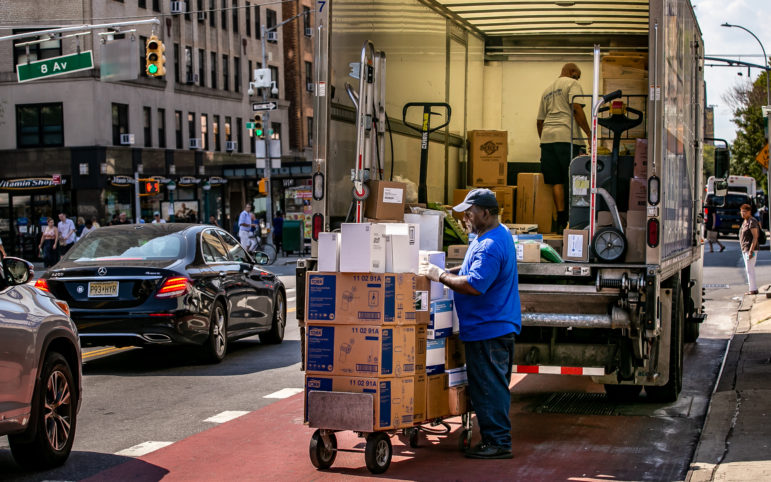
City Limits / Adi Talwar
A driver unloading goods from a truck in midtown Manhattan.
This story was produced through the City Limits Accountability Reporting Initiative For Youth (CLARIFY ), City Limits’ paid training program for aspiring public-interest journalists. CLARIFY is supported by The Pinkerton Foundation.
Bushwick, Brooklyn is both the geographical center of New York City and an industrial center for many businesses. With city-designated truck routes along every border of the neighborhood, the sight of double-parked vehicles loading and unloading goods is common. Tractor trailers and box trucks zoom down commercial corridors like Wyckoff and Knickerbocker avenues, while residents walk past low-rise architecture, pushing baby strollers or carrying groceries.
The neighborhood is one of several throughout the city where freight traffic — primarily trucks — are an integral part of the streetscape, and their presence has an impact: Brooklyn Community District 4, which includes Bushwick, is one of more than a dozen community boards across the city that complained of truck traffic in its statement of district needs this fiscal year. The boards cite problems with noise, pollution, congestion, and wear and tear on streets, asking the city to conduct traffic studies of problem-areas or dedicate more police officers to enforce truck route regulations. Hulking delivery vehicles also pose safety concerns: nine cyclists have been killed so far this year in crashes with trucks, according to city officials, and there were more than 8,000 crashes in the five boroughs involving large trucks in 2018, Department of Motor Vehicle statistics show.
“Trailers and trucks that make deliveries use the tertiary roads around our district and it absolutely destroys the roads, [and] backs up regular vehicle traffic that we’ve been trying to alleviate,” says Nicholas Siclari, chairman of Staten Island’s Community Board 1, which he says sees extensive freight traffic around the Howland Hook Marine Terminal and on local truck routes like Richmond Terrace. “On Richmond Terrace, I mean, between construction and truck traffic and tractor-trailer traffic — it’s an absolute nightmare.”
Minimizing the negative effects of truck traffic is no easy task, experts say, as the movement of goods is integral to the city’s economy, and is compounded by the rise of home-delivery services like Amazon Prime and FreshDirect. Mayor Bill de Blasio’s administration has made some reforms, urging more companies to make and accept deliveries overnight and looking for alternative ways to move cargo, including an initiative last year to shift more of it to rails and city waterways.
But trucks are still the dominant mode of freight transportation in New York: though they account for just 8 to 12 percent of the city’s overall traffic, they carry 89 percent of its cargo, and the 365 million tons of goods that now pass through the city each year is predicted to rise to 540 million tons by 2045, according to a Department of Transportation report released this spring.
“Trucks cause a lot of congestion and use a lot of road space, but they are not the ‘bad guys,'” says Elena Prassas, an associate professor at NYU’s Tandon School of Engineering. Truck policies, she says, must balance the needs of myriad stakeholders, including the businesses that rely on deliveries, the truck drivers making them, and the government agencies that regulate them. “We need these deliveries to keep our economy going. This goes back to why all the stakeholders need to work together.”
Community impact
For most New York neighborhoods, truck traffic is nothing new, though community leaders tell City Limits they’re noticing more delivery trucks now than in previous years. Between 2010 and 2013, daily freight trips in the city grew by 5.7 percent, a DOT mobility report from 2016 found. Vehicles delivering goods to shops and businesses must also compete for curb space with those making deliveries to residential homes, a practice that’s becoming more ubiquitous: Another DOT survey released this month found nearly 45 percent of city residents say they get deliveries at home at least once a week.
“There have always been issues with truck traffic in the district, I think we’re just seeing more — it’s the amount of trucks on the streets is a newer phenomenon,” says Marnee Elias-Pavia, district manager of Brooklyn CB 11, which encompasses the neighborhoods of Bath Beach, Gravesend, Mapleton, and Bensonhurst. The board’s most recent statement of district needs asked the city to increase NYPD enforcement to deal with “the proliferation of trucks and large tractor-trailers” in the area.
“We clearly need additional enforcement, truck enforcement, to ensure that these trucks are staying on the truck routes and the deliveries they’re making, [that] they’re not sidestepping and taking the shortest route through the district,” Elias-Pavia says.
But enforcement isn’t always effective in curbing bad delivery behavior. Scott Sieber, deputy chief of staff for City Councilmember Peter Koo, says some delivery companies view parking tickets “as the cost of doing business” in the city, and continue to park illegally despite getting fined — snarling traffic in the councilman’s Flushing, Queens, district. The neighborhood has a large amount of truck traffic, with factories that line College Point Boulevard as well as shops and eateries along Main Street, a busy commercial corridor where popular spots like the New World Mall see multiple delivery trucks per day.
“You’ve got all these attractions all in this one location and constant deliveries all day long,” Sieber says. “So when the deliveries get backed up, the trucks tend to double park on the streets. It just takes one and it causes this ripple effect that backs up traffic for the entire area.”
Get the best of City Limits news in your inbox.
Select any of our free weekly newsletters and stay informed on the latest policy-focused, independent news.
Those frustrating traffic jams have other dire side effects, of course: Trucks, like all vehicles that run on fossil fuels, produce emissions that pollute the air.
“That’s contributing to the global climate crisis, which has a ton of negative health impacts for people who live here,” says Stephen Roundtree Jr., environmental policy and advocacy coordinator for the environmental justice organization WE ACT.
He points to heavily-trafficked neighborhoods like Northern Manhattan and the South Bronx, both of which have high rates of respiratory illnesses like asthma, saying low-income communities and people of color tend to be hardest hit by environmental injustice.
“Climate impacts like increased instances of extreme heat, storms and flooding are going to take a toll disproportionately on people in this community,” he says. “That’s being caused, in part, by fossil fuel-driven freight traffic.”
Enforcement, barges and overnight deliveries
At the end of July, 30-year-old artist Em Samolewicz was struck and killed as she rode her bike on Third Avenue in Sunset Park. The driver of a parked car opened his door into her, forcing her into the roadway, where she was hit by the driver of a tractor-trailer, according to published reports.
Her death marked the 18th cyclist fatality to take place in the city this year — a number that’s since risen to 19 — with eight earlier crashes that also involved trucks, city officials said. It came just days after Mayor de Blasio launched a “Green Wave” initiative to make streets more cyclist-friendly, which includes several efforts targeting trucks: the plan calls for increased enforcement against drivers violating traffic and parking laws, and the creation of a task force to specifically address truck safety issues.
“Trucks are much larger and therefore are much more likely to cause serious damage when interacting with pedestrians,” Prassas says. “It is much more likely that there will be a fatality when a crash involves a truck than with any other type [of] vehicle.”
The mayor’s plan also aims to expand the city’s Off-Hour Deliveries program, which encourages businesses to accept deliveries at night when streets are less congested. There are currently 119 companies enrolled in the voluntary program, and DOT expects that number to grow in the coming months. Research from the initiative’s pilot in 2009 and 2010 showed positive results, saving companies time, fuel and money by avoiding the traffic jams that come with daytime deliveries.
“A lot of [trucking] firms would prefer to come at night,” says Arthur L. Miller, an attorney specializing in transportation and truck issues. And though DOT works with participants to mitigate problems like noise, there can be logistical issues with off-hours deliveries that make it a tough sell for many of the companies accepting goods.
“You have problems with businesses that don’t want to stay open, or residents complaining that there are trucks there at night,” Miller says.
Another initiative, Freight NYC, aims to reduce the overall role of trucks in transporting goods by shifting more cargo to rail lines and waterway barges, something city officials say could reduce truck trips in the city by 40 million miles a year. As part of the plan, the city will open a new marine terminal at Hunts Point in the Bronx and has reactivated the South Brooklyn Marine Terminal in Sunset Park. The Brooklyn site is now receiving cargo and has seen a modest amount of freight movement in the last year, according to a spokesman with the city’s Economic Development Corporation, and more activity is expected there in the future, including non-freight uses, like the possibility of a wind farm.
Jeremy Laufer, district manager of Brooklyn Community Board 7, which includes Sunset Park and Windsor Terrace, says residents are worried about additional congestion and pollution caused by vehicles heading to and from the newly activated site. He says they’ve asked the EDC for estimates of how the marine terminal will impact local traffic, but so far hasn’t gotten any.
“We have been waiting for over a year to hear about truck volume that they are proposing to add to this community; they can’t tell us,” Laufer says, adding that the EDC has also proposed converting parts of First and Second avenues in the industrial waterfront area to one-way streets to relieve congestion. “We’ve been trying to push back, saying, ‘How can you propose changing our truck network if you don’t even know how many trucks we are expecting?'”
The EDC plans to meet with CB7 to discuss neighborhood impact once plans for the marine terminal are finalized, a spokesman said.
While river barges and rail can help take some of the city’s cargo burden off of trucks, experts say those modes can’t replace them altogether. Kendra Hems, president of the Trucking Association of New York, a nonprofit trade group that represents the state’s trucking industry, says the Freight NYC plan is more about addressing the city’s future growth of freight — a 68 percent increase in cargo tonnage over the next 25 years, according to the DOT.
“It doesn’t necessarily address the amount of trucks that are on the roads today,” she says, adding that New York City faces “unique challenges” in making its freight truck deliveries more efficient. Even goods brought to the city by some other means will likely need to be loaded into a truck or some other vehicle for last-mile delivery, she and others note.
“Unlike people, freight can’t walk the last little bit of distance,” says Jonathan English, a PHD student in Urban Planning at Columbia who’s previously written about the limits of the city’s Freight NYC plan. “We can focus on getting whatever freight we can onto rail or barge, and accepting that that probably isn’t going to be a big percentage of the total pie.”
What’s more, the trucking industry is a lucrative economic generator, accounting for more than 300,000 jobs, according to the DOT.
“Truck driving provides a lot of good paying jobs to folks of low education levels [and] limited English proficiency,” says Asher Freeman, legislative and land use director for Brooklyn Councilman Antonio Reynoso, whose North Brooklyn district includes an Industrial Business Zone that sees a lot of truck traffic.
English thinks the city could do a better job of prioritizing its infrastructure to serve freight traffic rather than single-occupancy cars, like creating dedicated lanes on bridges for delivery trucks and commercial vehicles, though he admits that such a proposal would likely face backlash from non-commercial drivers. A recent DOT pilot that converted residential daytime parking on certain street into loading zones for commercial vehicles has faced similar anger from residents, according to the Daily News, prompting the city to roll back the program last week in one Brooklyn neighborhood.
But Hems says such reforms are essential to addressing the problems associated with trucks, noting that the lack of dedicated loading areas and street parking is what often leads to truck drivers engaging in unsafe behavior like double parking.
“It’s the lack of parking that really kind of paints the truck as the problem,” she says. “[Drivers are] just trying to do their job and make a delivery. It’s not that they want to be doing that — it’s really that they have to.”
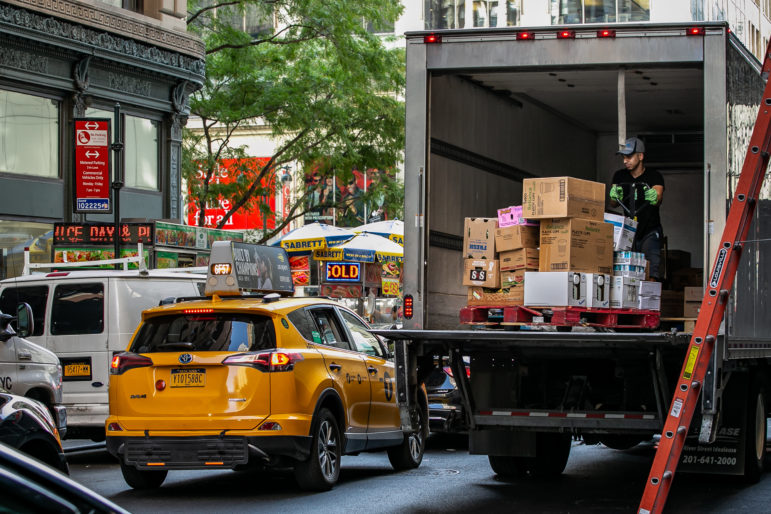
City Limits / Adi Talwar
West 33nd Street near 6th Avenue in Midtown Manhattan.
Other potential solutions
Several lawmakers have introduced bills to mitigate the negative impact that comes from truck traffic: In May, Councilman Reynoso proposed legislation to set up zones for commercial waste haulers, a move his office says will significantly reduce the number of miles traveled by private sanitation trucks. Freeman, Reynoso’s legislative and land use director, says they plan to introduce additional bills to dedicate more loading zones for trucks to prevent unsafe practices like parking in bike lanes.
“There is no place for them to actually pull over and make deliveries, so they’re kind of doing it out of necessity, but it’s nevertheless creating a very dangerous environment,” he says.
Assemblywoman Michaelle C. Solages, who represents the neighborhoods of Elmont, Floral Park and Valley Stream on Long Island, has proposed a bill on the state level that would require all trucks be equipped with a commercial GPS, which would inform drivers of approved routes and restricted roads, ensuring they don’t venture onto residential streets, where problems tend to arise.
“Accidents happen really frequently in my district because we have low bridges, and the exits and off-ramps don’t have very good signage to warn people,” she says. “When we’re talking about commercial vehicles, we’re also talking about like U-Hauls—not just the freighter trucks—and vehicles that people rent for a day.”
Assemblyman Joseph R. Lentol, who represents Greenpoint and Williamsburg in Brooklyn, thinks it’s a lack of enforcement rather than a lack of awareness that causes problems with trucks. Though the city regulates where trucks and commercials vehicles are allowed to operate — they’re banned from most parkways, from parking on city streets overnight and are supposed to stay on designated truck routes — those rules are rendered useless without proper enforcement, he says.
A bill he’s introduced would establish a pilot program for a photo monitoring system that would be placed at various intersections throughout the city, mimicking the systems frequently used at toll stations, and help alleviate the burden of surveillance for traffic enforcement officers.
“As you can imagine, it is impossible to police every street that has one of these designations in order to enforce compliance,” says Lentol. “This [bill] is to avoid the necessity of having a traffic enforcement agent at every street.”
Freight by bike?
Other experts say the city should be looking outside of trucks or other traditional freight options like trains and barges for more efficient ways of moving goods, especially in dense neighborhoods in Manhattan.
Alison Conw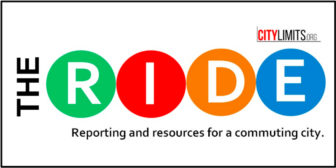 ay, an associate professor at The City College of New York, says diesel fuel and double-parking are main problems of truck traffic. To minimize them, Conway proposes that the city establish an “urban consolidation center” to transfer goods from trucks into small vehicles before entering the city. London adopted a similar reform in April, encouraging businesses to replace vans with electric cargo bikes before entering the city’s central district.
ay, an associate professor at The City College of New York, says diesel fuel and double-parking are main problems of truck traffic. To minimize them, Conway proposes that the city establish an “urban consolidation center” to transfer goods from trucks into small vehicles before entering the city. London adopted a similar reform in April, encouraging businesses to replace vans with electric cargo bikes before entering the city’s central district.
Cathasach O’Neill, a member of Cargo Bike Collective, an organization pushing for more frequent use of bikes to transport goods, echoes this idea, saying bike deliveries have environmental and economic benefits.
“The reduction in carbon output is a necessary method of mitigating global warming,” he said in an email. The DOT is currently reviewing a draft of a city rule that would legalize the use of pedal-assist cargo bikes, part of its effort to overhaul the city’s freight network, a spokeswoman said. The agency also expects to release a “Smart Truck Management Plan” later this year with tactics to better facilitate truck traffic.
And while cities can take steps to mitigate freight transportation issues, some experts say the problem also calls for consumers to take a close look at the way they order goods, and their penchant for online shopping and preference for same-day delivery services.
“It’s not like there’s a bunch of trucks with no connection to us. All the truck traffic in our neighborhoods is serving us in a way,” she says. “We really have to do some soul searching and think about if that’s what we want. Are we willing to pay for safer streets if we’re going to continue to consume the way that we have evolved to be consuming?”
Hems, of the Trucking Association, says there are certain parts of the city where home deliveries now outpace commercial deliveries.
“Trucks are having to make deliveries in areas where 10 years ago they may not have had to go down that street,” she says.
Arthur Miller, the attorney who represents those who work in the trucking industry, agrees, saying people are quick to place the blame on truck drivers for traffic and safety issues without considering the role they themselves might play in bringing those same trucks to their street.
“Everyone wants things delivered,” he says. “The idea of local people saying they don’t want those trucks coming into ‘our neighborhood’ — but they do want their deliveries to come in.”


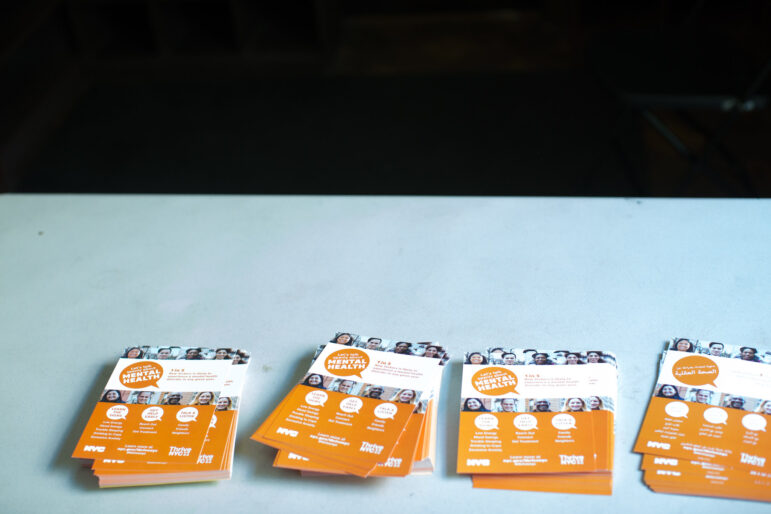
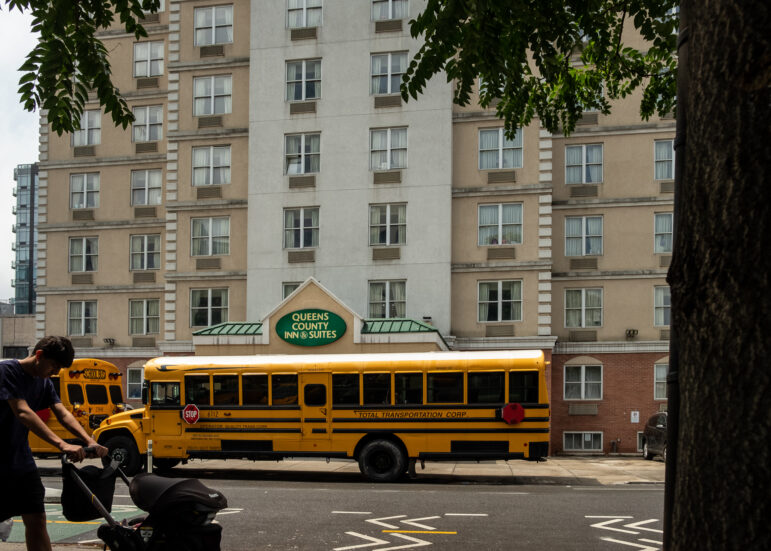


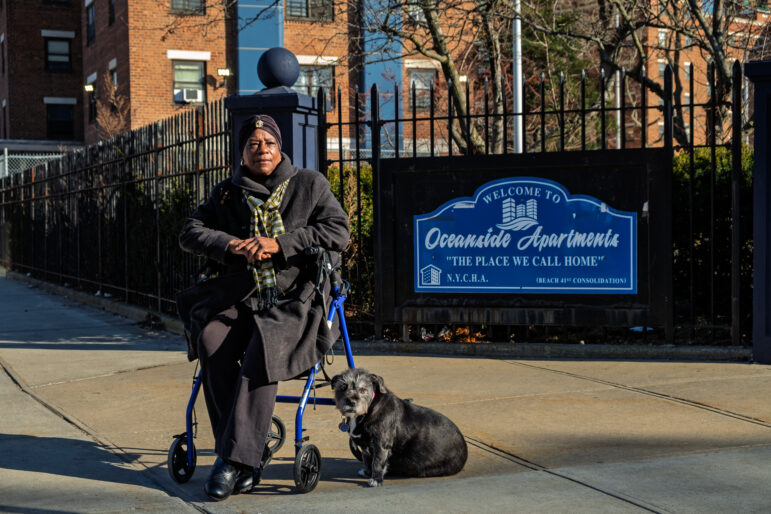


3 thoughts on “No Easy Answers as NYC Searches for Better Ways to Get Freight into a Crowded City”
There is only $70 million for advancing an environmental study for the Cross Harbor Freight Tunnel within the Port Authority of NY & NJ 2017 – 2026 Capital Plan. This leaves a $9.930 billion shortfall to complete this project. Congress member Jerald Nadler claims that there is real progress for his favorite Cross Harbor Freight Tunnel project. He has championed this as his number one transportation priority for thirty years. After all that time, it is still in the federal National Environmental Protect Act review process. In theory, it might move thousands of trucks on a daily basis off the roads and on to railroad tracks for portions of the journey between New Jersey and Long Island. It reminds me of the long forgotten proposed tunnel between 69th Street in Bay Ridge, Brooklyn and St. George, Staten Island. The concept was to extend subway service from Brooklyn to Staten Island. Ground was broken with entrances at both ends in the 1920’s, but the project quickly ran out of money and was abandoned to history. Flash forward 90 years later and we have the proposed “Cross Harbor” rail freight tunnel project.
Construction of any new freight, public transportation tunnel or bridge project can take years, if not decades, by the time all feasibility studies, environmental reviews, planning, design, engineering, real estate acquisition, permits, procurements, construction, budgeting, identifying and securing funding is completed. This is before the project reaches beneficial use. Construction for the 2nd Avenue subway began in the 1960’s. (Bond money intended for this project in the 1950’s was spent elsewhere.) The first segment was finally opened to the public on January 1, 2017 at a cost of $4.5 billion. Construction for the original tunnel to support bringing the LIRR from Queens into Grand Central Terminal began in the 1960’s. The latest completion date is now December 2022 with a current cost of $11.2 billion which could end up at $12 billion. No one can identify all the sources for the estimated $29 billion Gateway Tunnel. Ditto for paying back the $1.6 billion federal and $1 billion State Thruway Authority loans which covered a majority of the $4 billion new Tappan Zee Bridge. Who will find $10 billion or more needed for construction of a new Cross Harbor Freight Tunnel? Neither the Port Authority, Congressmember Nadler or Governor Cuomo have yet to identify and secure the billions needed to fund final design and engineering followed by construction. The Port Authority also needs to find $7 billion toward the $10 billion total cost for a new Port Authority Bus Terminal in Manhattan along with billions more for other transportation investments.
There is also a potential serious conflict with the proposed several billion Triboro X (a new subway connecting the Bronx with Queens and Brooklyn). This route would run parallel from the Bay Ridge, Brooklyn terminus to Queens. This would result in serious operational conflicts between freight and subway trains. The proposed Cross Harbor Freight Tunnel may be just another in the continuing series of feasibility studies and environmental reviews sponsored by various governmental agencies and public officials over decades. They generate some money for consultants along with free publicity for elected officials who promise a bright future but all to often move on to another public office before delivering. Taxpayers are left holding an empty bag with unfilled promises.
It is wishful thinking that the Port Authority can count on billions in future federal funding to make up the difference. Don’t be surprised in waiting another 30 years until future Port Authority ten year 2027 – 2036 and 2037 – 2046 Capital Plans are approved before a complete $10 billion or more funding package is in place necessary to support awarding construction contracts.
Residents who oppose the project based on concerns about significant future increases in the number, length and frequency of freight trains need not worry. At the end of the day, just like the long abandoned Brooklyn to Staten Island subway – don’t count on seeing any shovel in the ground any time soon. You may never see completion of any Cross Harbor Freight Tunnel in their lifetime.
(Larry Penner is a transportation historian, writer and advocate who previously worked 31 years for the United States Department of Transportation Federal Transit Administration Region 2 New York Office. This included the development, review, approval and oversight for billions in capital projects and programs for the MTA, NYC Transit, Long Island Rail Road, Metro North Rail Road MTA Bus, Nassau County NICE Bus, New Jersey Transit along with 30 other transit agencies in NY & NJ).
.
Pingback: Thursday’s Headlines: More Charges Please! Edition – Streetsblog New York City
Kudos to the authors of “No Easy Answers as NYC Searches for Better Ways to Get Freight into a Crowded City.” Trucking is the least efficient way to transport freight, and yet that’s what New York City is almost entirely dependent on. A shift to waterborne freight transit would use less fuel, produce less pollution, improve air quality, reduce costs, and lessen traffic congestion. Thankfully, New York City’s shipping industry leaders and elected officials recognize the need to return to our maritime roots, and are working to renovate waterfront terminals, construct barge landings, and engage with ports up and down the East Coast to energize the M95 Marine Highway Corridor. Congressman Nadler’s proposed Cross Harbor Freight Tunnel is making steady progress and is a viable long term solution, but in the meantime, let’s use the blue highway.